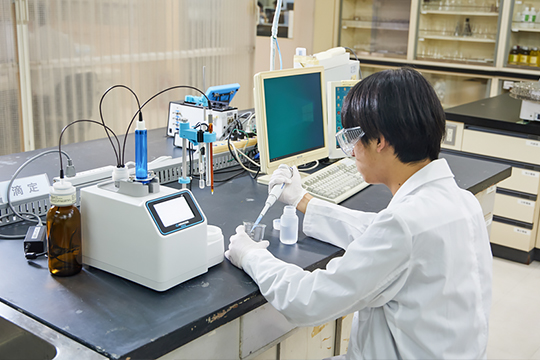Principles of Titration
What is Titration?

Titration is an analytical method of measuring the amount of a specific substance in a solution by adding drops of another solution to it, and finding the point at which the chemical reaction is complete. Typically, a solution with a known concentration, called a titrant, is used.
In the real world, familiar examples include determining the acidity of fruit beverages and the salt content of soy sauce. Titration is specified as an official measurement method in the Japanese Agricultural Standards (JAS).
In addition, the acidity of wine, the total acidity of alcoholic beverages, and the amino acids of sake are determined using the National Tax Agency prescribed analysis method. Meanwhile the purity of reagents and the degree of deterioration of oil (acid value/peroxide value) are determined using the Japanese Industrial Standards (JIS). The Japanese Pharmacopoeia is also widely used and contains provisions for measurements conducted by titration for each pharmaceutical product.
Titration Procedure
This is the basic flow of titration. Titration is widely used in chemical analysis and quantitative experiments.
-
Knowing the reaction equations of substances that react with each other
It is assumed that the substance to be titrated reacts with the titrant reagent and the chemical reaction proceeds. This reaction equation between the titrant reagent and the substance to be titrated must be known in advance.
-
Knowing the concentration of titrant reagent
The concentration of the titrant reagent is accurately measured in advance. Using this, the amount of the substance to be titrated can be determined from the results of the titration.
-
Using an indicator in the titration process
In the process of titration, an indicator is used to determine the progress of the reaction between the substance to be titrated and the titrant. The indicator indicates that the titration is complete by changing pH or color.
-
Finding the titration endpoint
The endpoint of a titration is important to find the point at which the reaction between the substance to be titrated and the titrant is complete. The endpoint of the titration is determined by the change in the indicator, and the titration result is obtained.
-
Titration calculation
The amount of substance to be titrated is then calculated based on the results of the titration. This amount can be calculated from the concentration of titrant and the amount of titrant required to reach the endpoint of the titration.
These are the basic steps of titration. Titration is widely used in chemical analysis and quantitative experiments and is an important technique in many different fields.
Disadvantages of Manual Titration
Manual titration using a glass buret has several disadvantages.
-
Dependent on human senses
A glass buret requires adjusting the titration speed by human senses during titration. However, titration with a glass buret is difficult to maintain a constant and precise speed, which may cause errors.
-
Individual errors in endpoint determination
In titration with a glass buret, the color of the endpoint by the indicator is determined visually, which may lead to errors.
-
Concentration calculations must be made
After determining the endpoint by titration, it is time-consuming to visually read the buret value and calculate the concentration.
To overcome these disadvantages, automatic titrators have been developed and technological advances have been made to improve the accuracy and efficiency of titration. However, manual titration using glass buret are still widely used and play an important role as one of the basic methods of titration.
Advantages of Automatic Titrators
Automatic titrators have the following advantages:
-
High accuracy
Automatic titrators strictly control the rate of titration and the titration reaction, thus enabling titration with a high degree of accuracy without relying on human senses. The accuracy of titration can be improved by keeping the titration rate constant and minimizing the influence of temperature.
-
High repeatability
The automatic titrator will reproduce nearly identical results when multiple titrations are performed under the same conditions. This improves the repeatability of titration as it eliminates human-caused variation in titration results.
-
Rapid titration
Automatic titrators are capable of performing titrations at high speed. The titration can proceed efficiently by automatically controlling the titration speed. This can save time when titrating large volumes.
-
Versatility
Automatic titrators have built-in functions for performing a variety of titration methods and reactions. A variety of titration methods can be performed automatically, including acid-base titration, redox titration, precipitation titration, and photometric titration.
-
Easy operation
Automatic titrators are relatively simple to operate and the conditions for titration can be set in advance. This reduces both the possibilty of operational errors as well as the time and effort required for titration.
-
Automatic data recording
Automatic titrators can automatically record titration data. They can accurately record titration results and titration conditions and facilitate data management.
Due to these advantages, automatic titrators are widely used in R&D and quality control to improve the accuracy, reproducibility, and efficiency of titrations.


